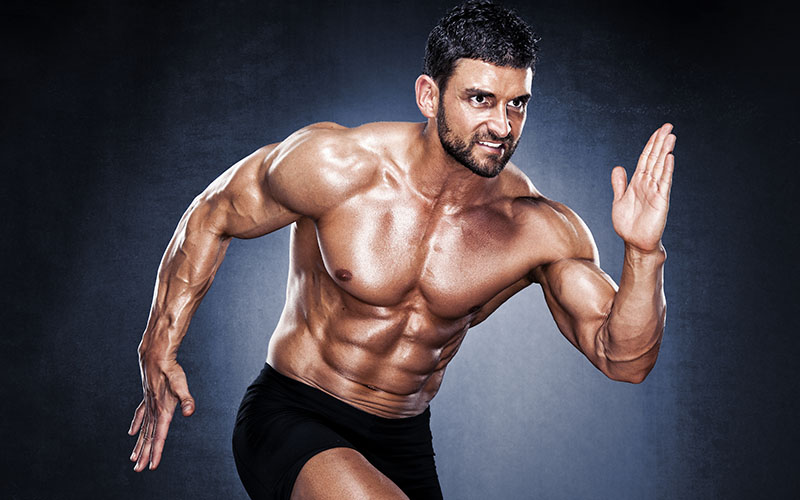HIIT has recently become the go-to cardio exercise to lose fat quickly. However, the majority of people aren’t performing it in a way that maximizes its fat loss effects. If you’re unaware of what exactly HIIT is, it’s basically a method of exercising where you alternate between “work intervals” of all-out intensity and rest (ideally active rest). This type of training has become so popular due its enhanced ability to increase fat loss in a shorter amount of time compared to steady-state cardio.
But in order to reap the full benefits of HIIT (hormonal release, EPOC, increased fatty oxidation, improved insulin sensitive, etc.) you need to be performing it properly. You also need to use HIIT in a way that prevents you from reaching fat loss plateaus, so that you can reach very low levels of body fat without getting stuck. In this article I’m going to show you exactly how to do so by using the proper type, intensity, and progressive overload for HIIT.
I’ve created a video that goes in-depth regarding this topic, and provides a detailed example of how you would progress your HIIT workouts each week. You can check it out below.
1. Best Type of HIIT
There are a variety of ways you can perform HIIT. You can do HIIT with weights, swimming, boxing, jump rope, and the list goes on.
But not all forms of HIIT are equally beneficial when the goal is to get to 10% body fat while maintaining as much muscle mass as possible. This is because studies have shown that “the more a cardio exercise mimics the movements used in muscle-building movements, the less it hinders strength and muscle growth”. Thus, HIIT exercises that highly mimic weightlifting movements are the best ones to do to lose fat and preserve muscle mass.
The 3 best exercises for this reason are rowing, cycling, and sprinting since they highly mimic movements such as the squat and seated row. I suggest using an ergometer in the gym for rowing and cycling, and either sprinting on a treadmill or outside (the latter of which will allow you to go “all-out” more effectively).
2. Optimal Intensity for HIIT Work Intervals
 Studies have shown that in order to reap the majority of benefits from HIIT (EPOC, hormonal response, increased fatty acid oxidation, etc), you need to reach between 85%-95% of your max heart rate during the work intervals. You can tell if you’re at this level of intensity if you’re breathing so hard that you’re unable to maintain a normal conversation with someone. This is where I think a lot of people aren’t doing HIIT properly, they simply aren’t pushing hard enough to reap the many benefits of HIIT.
Studies have shown that in order to reap the majority of benefits from HIIT (EPOC, hormonal response, increased fatty acid oxidation, etc), you need to reach between 85%-95% of your max heart rate during the work intervals. You can tell if you’re at this level of intensity if you’re breathing so hard that you’re unable to maintain a normal conversation with someone. This is where I think a lot of people aren’t doing HIIT properly, they simply aren’t pushing hard enough to reap the many benefits of HIIT.
A good starting point is to perform 20s of HIIT at 80% max intensity with a 40s rest interval (work:rest ratio of 1:2). If you are already performing HIIT, I would suggest bumping the intensity up to around 90-95%. I prefer performing HIIT intervals with a lower duration (e.g. 30 seconds) as it allows me to go all-out. I find it hard to believe that most people are able to perform sprints at 90-100% intensity for over a minute (let alone repeat this several more times), which is why I stick to a lower duration and push hard throughout the work intervals.
3. Progressive Overload
Although many people don’t think about applying progressive overload to HIIT (or cardio in general), it’s the key to avoiding fat loss plateaus and getting to low levels of body fat. There are 5 ways you can overload your workouts:
- Increase the intensity of your work interval
- Increase the duration of your work interval
- Decrease the duration of your rest interval
- Increase the number of cycles performed
- Increase the frequency of your workouts
Basically, all you want to do is progressively overload your workouts using one (or more than one) of the variables whenever you start to feel too comfortable with your current workouts or when your fat loss has plateaued (which usually happens every 2-3 weeks). However, the leaner you get the more often you will have to overload your HIIT workouts in order to get rid of stubborn areas of fat like the lower abdominal region.
Things to Keep in Mind
You can do all the HIIT you want, but if you’re not creating a caloric deficit through your diet then you’re not going to get anywhere. In addition, you should be using HIIT in conjunction with a weightlifting routine. HIIT alone is not sufficient enough to maintain muscle mass, which is needed in order to keep your metabolism high throughout a cut.
So use HIIT as described in this article, but know that you need to be eating at a caloric deficit and regularly weightlifting in order to see the best results.
Getting down to very low levels of body fat is difficult, even seemingly impossible for many out there. But by being consistent, putting in the effort, and using the concepts outlined in this article, you’ll get there in no time.
AUTHOR BIO:
Jeremy is a personal trainer and Kinesiologist based in Vancouver, Canada. He specializes in fat loss and HIIT, which led him to create HIIT Your Body. From quick HIIT workouts to full out HIIT plans, you can find it on his site.
Facebook – HIITyourbody

